LED light sources provide electricity savings by 1.5-2 times compared to fluorescent bulbs and 10 times compared to incandescent lamps. To save even more, products do not need to be purchased in stores. A DIY 220 V LED lamp is assembled from consumables that can be found in the master's bins.
- Benefits of using homemade LED bulbs
- Design differences of factory LED lamps
- Varieties of LEDs
- Driver types
- Types of modern lamp bases
- Self-assembly materials
- E27 LED lamp from energy saving and ready-made driver
- LED light bulb based on a homemade driver
- Preparation process
- Driver manufacturing diagram
- Circuit assembly sequence
- Materials for the manufacture of the case
- Incandescent lamp base
- Energy saving housing
- Work safety requirements
Benefits of using homemade LED bulbs
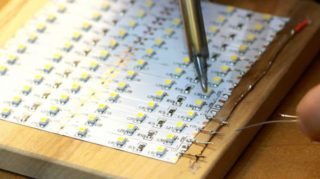
There are several types of devices on store shelves. Incandescent lamps with a high color rendering index consume a lot of energy. Energy-saving ones are mainly produced with an E27 base, luminescent ones emit poisonous vapors when heated. LED devices hardly heat up, are resistant to mechanical damage, and have a power of 10 watts. With a luminous flux of 800 lm, the LED device will last 50 thousand hours.
The disadvantage of diode light sources is the high cost. This disadvantage can be made an advantage if you make a quality LED lamp with your own hands. It will be distinguished by:
- long service life - about 10 thousand hours;
- high efficiency watt / lumen compared to analogs;
- price range of consumables, similar to fluorescent devices.
The advantages of a homemade device are achieved with proper assembly.
Design differences of factory LED lamps
Factory assembled products are polycrystalline LEDs without multiple contacts. Bulbs have several differences.
Varieties of LEDs
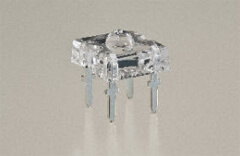
The LED is a semiconductor multilayer crystal with an electron-hole type transition. Light radiation is obtained by passing current, but a burnt-out element cannot be repaired. Manufacturers use the following LEDs:
- DIP - in the form of a crystal with two conductors and a lens. Used for garlands and backlit displays.
- Piranha is a crystal with a lens and four leads for conductors. Differs in brightness, suitable for car headlights.
- SMD is a super bright type of small size that is surface mounted.
- SOV - with non-oxidizable and non-heated contacts, excellent glow intensity. Soldered into a special board.
Before assembling yourself, decide on the power source.
Driver types
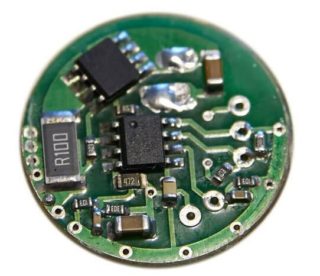
The driver provides power to the light bulb from the mains by transforming the alternating voltage into operating voltage. The simplest element is constructed from resistors, a diode bridge and an input capacitor.
Several types of drivers are used for LED devices:
- linear - designed for low operating currents (up to 100 mA) or for power supplies with a voltage similar to the diode voltage drop;
- pulsed down-steps - supplies powerful LEDs, but the choke can create electromagnetic interference;
- pulse boost - used for models with an operating voltage higher than that of the power supply.
Electronic drivers are built into 220 V LED devices.
Types of modern lamp bases
The base is the thread required to attach the bulb to the socket, supply power, and protect the vacuum bulb. The product already has the factory marking of the base.
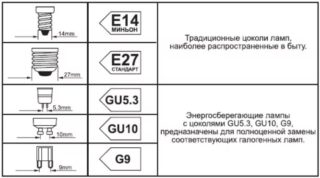
The first letter denotes the type of base indicated in the table:
| Letter | Decoding |
| IN | pin |
| E | threaded |
| F | 1 pin |
| G | 2 pins |
| H | under xenon |
| K | cable type contact |
| R | recessed contact |
| P | focusing |
| S | soffit |
| T | for telephony |
| W | lead-in contacts in the glass of the bulb |
The second letter indicates the type of light source: U - energy saving, A - for a machine, V - with a conical tip.
The numbers after the letters indicate the diameter in millimeters.
The E27 base is suitable for a voltage of 220 V.
Self-assembly materials
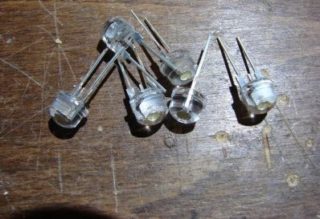
You can make your own light source on diodes using the following materials:
- base from a burnt out fluorescent light bulb;
- LED-elements with a current strength of 100-120 mA and a voltage of 3-3.3 V - you will need a tape or separate LEDs NK-6;
- diode bridge or rectifier diodes with marking 1N4007;
- a fuse from the base of a burnt out light source;
- capacitor - the parameters depend on the assembly scheme and the number of LEDs;
- a plastic frame for attaching LEDs;
- super glue or liquid nails;
- electrolytes and drivers.
Make a list of materials in advance.
E27 LED lamp from energy saving and ready-made driver
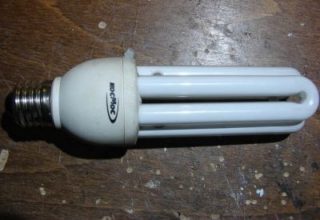
To make an LED light bulb, you will need a faulty CFL product, NK-6 LEDs, a soldering iron, pliers, solder and a cardboard base. The work is carried out step by step:
- The base is removed from the old 20 W bulb. You will need to pry the latches or drill out areas with a chiseled punch.
- The empty base is cleaned of excess solder, treated with alcohol or cosmetic nail polish remover.
- There are 6 holes on the base / plinth cover. On a piece of cardboard, he makes markings of round niches, which is then cut out using nail scissors.
- A strip of diodes is disassembled from 6 crystals connected in parallel.
- Crystals are connected 3 in parallel.
- Two ready-made parallel LED strings are attached in series.
- 6 elements with a power of 1 W are connected to the finished driver from a broken LED light bulb.
- A circle is cut out of cardboard, fits between the driver and the board. The driver is installed in the base.
- The bulb is fully assembled and tested for functionality.
The result is a bright white analogue of a 30 W incandescent light bulb. The brightness of the product will be 150-200 lm, and the power will be 3 W.
To adjust the lighting area, you can bend the leads of the LED elements.
LED light bulb based on a homemade driver
A homemade driver will work only if the master knows how to work with a soldering iron, read simple wiring diagrams and use chemical reagents. A do-it-yourself LED lamp is made in stages.
Preparation process
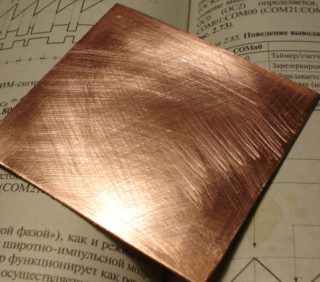
Consists of the following steps:
- Preparation of materials. You will need copper-clad fiberglass, LED elements, capacitors, a resistor, a small drill, rosin and solder, a soldering iron and pliers, nail varnish or a stationery corrector pencil.
- Preparation of reagents. Etching of the board is carried out using sodium chloride, copper sulfate or ferric chloride solution.
Take fiberglass with a thickness of 0.5 to 3 mm.
Driver manufacturing diagram
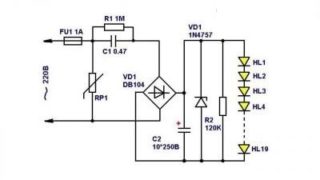
To make a driver, it is worth adding resistor R3, zener diodes VD2 and VD3, capacitors C1 and C2 to the list of basic materials. This number of elements is enough for a 20-element lamp. The circuit of the device works on the principle of passing alternating currents to diodes through the first capacitor.The second helps to eliminate flicker and ensure an even luminous flux.
The mains voltage will pass through a resistor and a current limiting capacitor, which smooth out voltage fluctuations. The second resistor is needed to supply voltage to the diode unit and obtain a glow. The ripple is smoothed out by a capacitor.
Use a printed circuit board to mount the driver elements.
Circuit assembly sequence
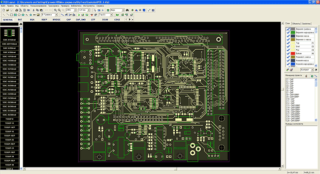
A homemade scheme is made as follows:
- Sprint Layout or DipTrace generates an etched pattern for the board.
- A circle is cut out of a fiberglass plate for a board 3 cm in diameter.
- A sketch of the diagram is transferred with a special marker, nail varnish or printed on paper.
- A mixture for pickling is prepared from 1 tbsp. l. copper sulfate and 2 tbsp. l. salt, diluted in boiling water.
- The board is dipped into the solution for 30 minutes. The reaction removes all copper except for the patterned elements.
- Using nail polish remover removes the coating from the material.
- The edges and attachment points of the contacts are tinned with solder.
- Holes are made with a drill, where the LEDs will go out.
- The elements are soldered on the board, which is then placed in the case.
The result of the work will be a light bulb with the equivalent of a 100 W incandescent lamp.
Materials for the manufacture of the case
To make a housing for an LED lamp powered by a 220 V network, you can use several available tools.
Incandescent lamp base
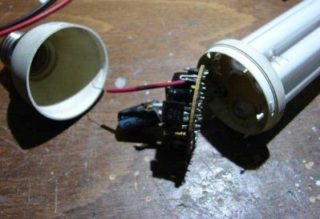
You will need to remove the glass flask from the product, and then remove the spiral. The internal part contains the circuit. The elements are attached to the top of the board. The disadvantage of the base will be poor-quality insulation.
Energy saving housing
The faulty light bulb must be disassembled and the converter board removed. The LEDs are located in the openings of the lid for the glass bulb, if the source has 3 arcuate elements. The circuit is placed inside and the diodes are fixed in the finished holes.
Work safety requirements
Experienced electricians note:
- You cannot start assembly without basic electrical knowledge. Incorrect manufacturing sequence may result in product explosion or mains short circuit.
- Devices with a voltage of 12 V or more are not connected to the standard mains supply.
- In the absence of insulation of the structure, electric shock is possible if you touch it with your hands.
- A finished light bulb does not work without high-quality soldering of the nodes.
Self-assembly of an LED light source with knowledge and skills will not be difficult. If in doubt, you do not understand the circuits, it is better to purchase a ready-made LED device.








